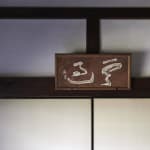Kitaōji Rosanjin (1883−1959)
Plaque, “Clouds Passing”
Carved and colored on wood, framed
With box authentication by Kuroda Toto-an
33.3 x 69 cm (overall)
With box authentication by Kuroda Toto-an
33.3 x 69 cm (overall)
Further images
Exhibitions
Kitaoji Rosanjin ten. Tokyo: Nihonbashi Takashimaya; Osaka: Shinsaibashi Daimaru; Nagoya: Maruei Skyle, 1979.Kitaoji Rosanjin ten. Kyoto: The National Museum of Modern Art, Kyoto, 1988.
Kitaoji Rosanjin is known for his remarkable talent of being a potter, a gourmet, a calligrapher and a painter. Nonetheless, at the core of Rosanjin’s art-making are the arts of calligraphy and seal-engraving, just as the art critic Shirasaki Hideo puts it: “The fountain of Rosanjin’s artistic activities is his ability to compose calligraphy freely, and to engrave in the same way as writing calligraphy.”
Rosanjin’s path to his artistic world started at his age of fifteen when he was awarded at several calligraphy contests. Calligraphy must have been of particular significance to Rosanjin throughout his life, and he even had his calligraphy show at his late years. In the meanwhile, influenced by the woodblock engraver Fukuda Takezo, his adopted father, Rosanjin has been familiar with the art of wood engraving. His seal-engraving art is highly recognized as masters such as Takeuchi Seiho would commission him. Rosanjin followed no specific tutors nor masters in his pursuit of calligraphy and seal-engraving.
When making signboards or plaques, Rosanjin used a wide chisel, which resulted in rough texture when observe closely. Instead of the conventional engraving method, which starts with the outline, Rosanjin engraves as if writing calligraphy with a brush. As a result, he carved deeply in sections supposed to be dark if it were a piece of calligraphy. Even though this is a piece of engraved wood art, it appears as a work of calligraphy that is done with flowing brushworks.
Kitaoji Rosanjin (ceramist, calligrapher, seal engraver, painter, gourmet; 1883−1959)
Kyoto-born multi-talented artist. His real name is Fusajiro. In 1919, opend the Taiga-do Art Gallery. Founded Bishoku Kurabu (the Gourmet Club) and ran the restaurant, Hoshigaoka Saryo. From the beginning of the Showa period, started pottery in search of tableware suitable for Japanese cuisine, and concentrated on that after 1936. Excelled in various techniques, revived varied styles of ancient ceramics and established his own free style.
Rosanjin’s path to his artistic world started at his age of fifteen when he was awarded at several calligraphy contests. Calligraphy must have been of particular significance to Rosanjin throughout his life, and he even had his calligraphy show at his late years. In the meanwhile, influenced by the woodblock engraver Fukuda Takezo, his adopted father, Rosanjin has been familiar with the art of wood engraving. His seal-engraving art is highly recognized as masters such as Takeuchi Seiho would commission him. Rosanjin followed no specific tutors nor masters in his pursuit of calligraphy and seal-engraving.
When making signboards or plaques, Rosanjin used a wide chisel, which resulted in rough texture when observe closely. Instead of the conventional engraving method, which starts with the outline, Rosanjin engraves as if writing calligraphy with a brush. As a result, he carved deeply in sections supposed to be dark if it were a piece of calligraphy. Even though this is a piece of engraved wood art, it appears as a work of calligraphy that is done with flowing brushworks.
Kitaoji Rosanjin (ceramist, calligrapher, seal engraver, painter, gourmet; 1883−1959)
Kyoto-born multi-talented artist. His real name is Fusajiro. In 1919, opend the Taiga-do Art Gallery. Founded Bishoku Kurabu (the Gourmet Club) and ran the restaurant, Hoshigaoka Saryo. From the beginning of the Showa period, started pottery in search of tableware suitable for Japanese cuisine, and concentrated on that after 1936. Excelled in various techniques, revived varied styles of ancient ceramics and established his own free style.







